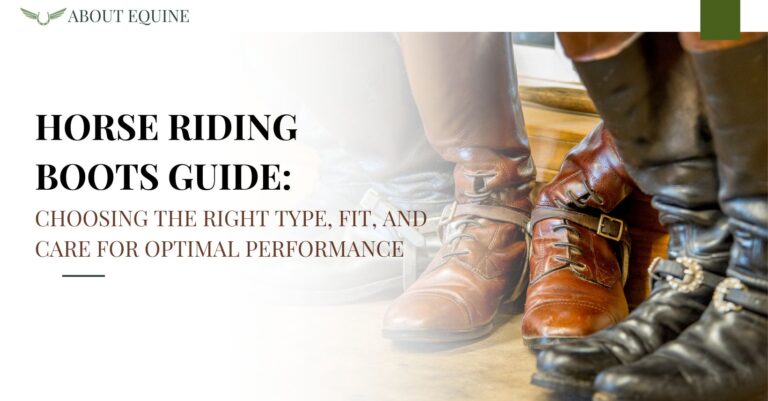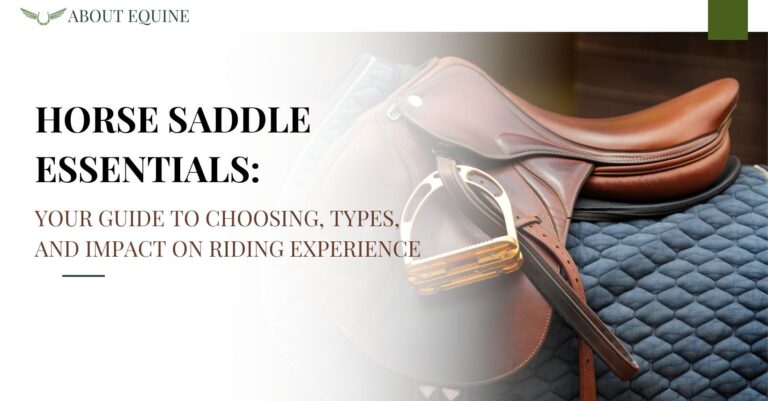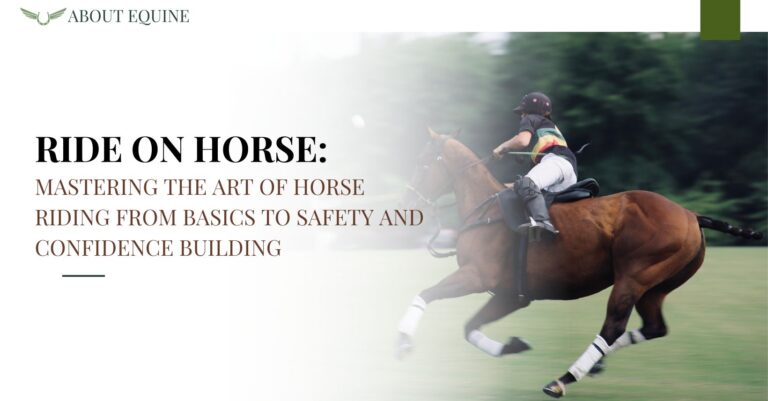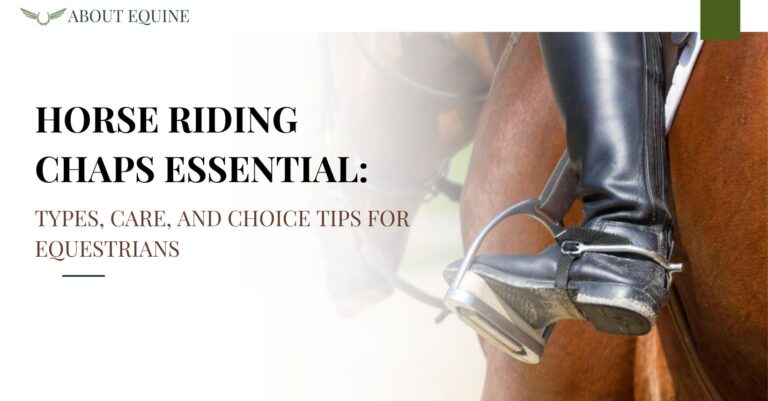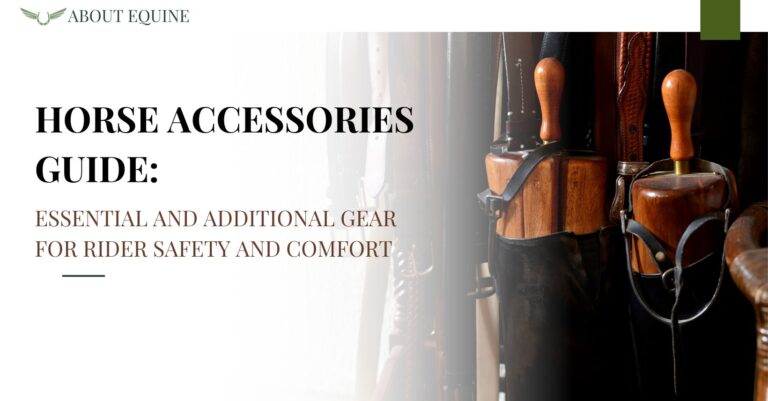How to Choose Your Horse Riding Boots?
Are you in the market for a new pair of horse riding boots but need help figuring out where to start?
This article explores the types of horse riding boots available, including paddock, tall, and western boots.
We also discuss the importance of considering materials like leather or synthetic materials and tips for choosing the right fit and comfort features.
Delve into safety considerations such as toe protection, ankle support, and traction.
Here, you can find guidance on maintaining and caring for your riding boots and budget considerations for both high-end and budget-friendly options.
Whether you’re a seasoned equestrian or a beginner rider, read on to learn how to choose the perfect horse-riding boots for your needs.
What are the Types of Horse Riding Boots?
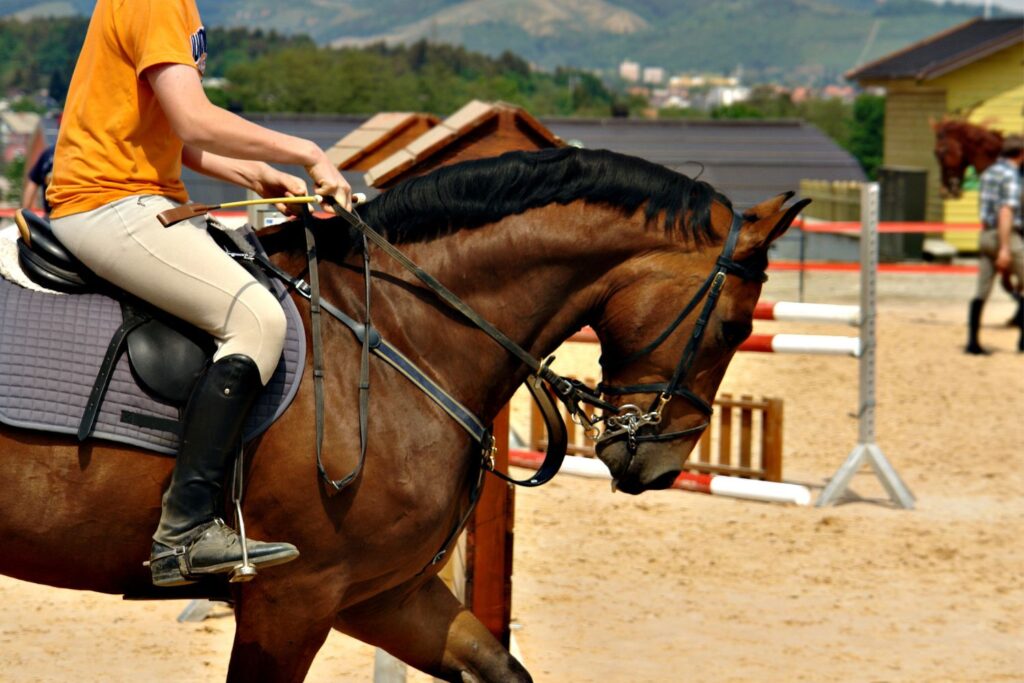
Understanding the different types of Horse Riding Boots, such as Paddock Boots, Tall Boots, and Western Boots, is important as each is customised to specific riding styles and purposes. Choosing the right type can greatly enhance your riding experience.
Paddock Boots are versatile and perfect for everyday riding activities. They are shorter in height, providing ankle support while allowing freedom of movement. Paddock Boots are commonly worn for schooling, trail riding, and working around the barn.
Tall Boots, on the other hand, are designed for more formal riding disciplines such as dressage and show jumping. They are taller, reaching up to the knee or over the knee, offering maximum leg support and a polished look in the show ring.
Western Boots are popular among Western riders for their distinctive style and comfort. They typically feature a higher heel and a squared toe, providing stability and a secure fit in the stirrup. Western Boots are suitable for reining, cutting, and western pleasure riding.
Paddock Boots
Paddock Boots are essential equestrian footwear designed for daily use and short rides. They provide excellent stability and support to the rider’s feet and ankles, making them ideal for beginners and experts.
Constructed with premium leather or synthetic materials, Paddock Boots offer durability and comfort during extended hours in the saddle. The reinforced toe cap and heel counter enhance protection and longevity, ensuring a lasting investment for any rider.
The lace-up or zip-up closures provide a customisable fit for maximum security and snugness. Expert equestrians often recommend Paddock Boots as a versatile option for riding, working in the stable, or even casual wear around the barn.
Tall Boots
Tall Boots are a popular choice among riders for formal events and competitions. They come in various sizes to ensure a comfortable fit. However, choosing the right size is important to avoid painful experiences such as pressure points and chafing.
When selecting tall boots, one key consideration is the calf size, as improper sizing can lead to discomfort while riding. Ensuring a snug yet not too-tight fit around the calf can enhance comfort and functionality.
The material of the boots plays an important role in overall comfort. High-quality leather can provide durability and flexibility, which are essential for long hours in the saddle.
Western Boots
Those practising Western-style equestrian activities prefer Western Boots. These boots combine comfort, stability, and durability. They endure various riding conditions, often made from quality leather and featuring a weather-resistant design.
Western Boots enhances the rider’s safety by providing exceptional foot and ankle support during extensive riding sessions. Their sturdy build ensures a snug fit and stability necessary for balance while riding.
The pointed-toe design also simplifies stirrup entry, improving the rider’s control and interaction with the horse. As we consider the impact of these boots on riding performance, it’s also worth exploring the materials used to create such resilient footwear.
What materials should be taken into consideration?
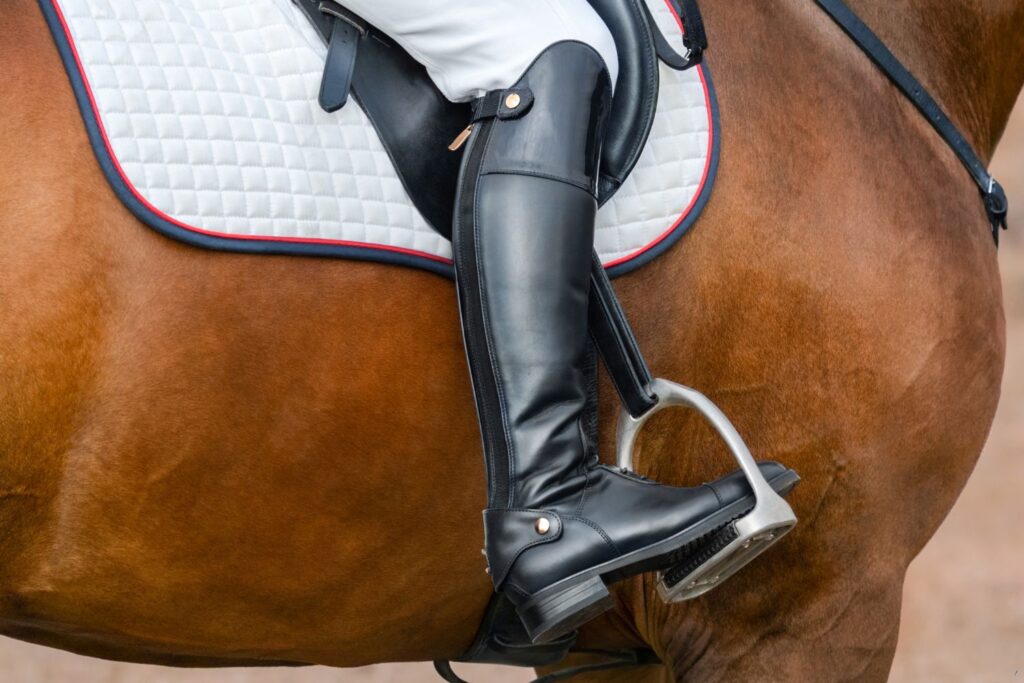
When selecting horse riding boots, it is essential to consider the materials used in their construction. Leather and synthetic materials are the two main options, offering distinct benefits and characteristics to enhance the rider’s experience.
Leather riding boots, known for their durability and classic aesthetic, provide a snug fit that moulds to the rider’s foot over time, ensuring optimal comfort and support during long rides. Leather boots are breathable, allowing air circulation to prevent excessive sweating and discomfort.
Conversely, synthetic riding boots offer a more affordable alternative. They are easy to maintain and resistant to water damage, making them ideal for wet conditions or daily use.
In terms of performance, many riders prefer leather boots for their exceptional grip on stirrups and overall stability, which improves control and communication between the rider and the horse. Conversely, synthetic boots are lighter in weight and offer agility and flexibility, which can be advantageous in disciplines requiring quick movements and precision.
Leather
Leather is a popular choice for horse riding boots due to its durability, comfort, and ability to mould to the rider’s foot over time. Leather boots provide excellent stability, support, and traction, making them a preferred option for many equestrians.
One of the key advantages of leather boots is their exceptional fit; as the leather softens and conforms to the shape of the rider’s foot, it offers a custom-like feel that enhances comfort and reduces the risk of blisters or friction points. Leather is also known for its breathability, allowing air circulation to keep the feet cool and dry during long rides. It is important for maintaining overall comfort and performance.
Synthetic Materials
Synthetic materials, valued for their versatility, lightweight nature, and weather resistance, are becoming a popular choice for constructing modern horse riding boots.
These materials enhance rider comfort by offering a more consistent fit than traditional leather, supporting better control and stability during rides. Additionally, synthetic boots’ durability means they can withstand various weather conditions, keeping riders protected.
Their lightweight design also minimises strain on the rider’s legs and feet, enabling longer, more enjoyable rides. Such considerations are important in equestrian gear and broader decisions about personal well-being and physical ease.
How to Choose Your Fitness and Comfort?
Selecting horse riding boots that provide the ideal fit and comfort is important for a rewarding riding experience. Riders should consider specific sizes, fitting techniques, and available models to ensure their boots offer optimal support and performance.
Regarding horse riding, the importance of wearing suitable boots must be considered. Ill-fitting boots can lead to discomfort, blisters, and even accidents, hindering the joy of riding. To find the perfect size, riders should measure their feet accurately and determine the width and height needed for a snug fit.
Various fitting methods, such as trying on boots with riding socks or seeking professional assistance, can play a vital role in ensuring the boots conform well to the rider’s feet. Different boot models catering to various disciplines like dressage, jumping, or trail riding must match the boot features with the rider’s specific needs and activities.
Importance of Proper Fit
A proper fit is essential when selecting horse riding boots to prevent discomfort, chafing, and pain during riding sessions. Factors like calf sizes, elastic bands, and zipper closures ensure a snug and comfortable fit.
The calf size of the boots is critical as it determines the circumference around the thickest part of the leg. Boots that are too tight can restrict movement and cause discomfort, while those that are too loose may lead to chafing and irritation. Opting for boots with elastic bands provides flexibility and helps accommodate varying calf sizes, ensuring a more customised fit.
The design of the zipper closures is not just a minor detail but a significant factor that influences both the ease of putting on and the security of the boots. A well-constructed zipper that runs smoothly enhances convenience while wearing and ensures it is sturdy enough to withstand the demands of riding activities, which is essential for longevity and performance.
Features for Comfort
Comfort features in horse riding boots enhance the rider’s experience by preventing cramped feet and ensuring a pleasant ride. Supportive soles distribute weight evenly, reducing strain on feet and ankles. At the same time, ergonomic shapes help maintain correct posture and prevent discomfort.
Adequate padding cushions the feet and absorbs impacts during long rides. These features improve comfort and enhance stability and control, making riding more enjoyable and effective. As riders benefit from these comfort features, it’s also worth considering the safety aspects that these boots can offer.
What safety features need to be considered?
Ensuring the safety of the rider’s lower legs and feet is paramount when selecting horse riding boots. Safety features like toe protection, ankle support, and traction-enhancing soles prevent injuries and provide stability during rides.
Proper protection is vital in horse riding, where the rider engages in various movements and potential risks. Boots’ toe protection shields against accidental impacts, ensuring the rider’s toes are safeguarded. Moreover, ankle support is key for maintaining stability and reducing the risk of twisting or spraining, especially during jumps or sudden movements.
Another essential aspect is sole traction, which enhances grip on stirrups and provides better control over the horse. This feature not only ensures safety but also offers comfort and confidence to the rider, making their riding experience more enjoyable and secure.
Toe Protection
Toecap protection in horse riding boots safeguards the rider’s toes from impact injuries and discomfort caused by pressure points or seams within the boot. Reinforced toe areas prevent weakening and ensure long-lasting durability.
The toes are vulnerable to knocks and bruises when riding horses, especially during jumping or trail riding. Proper toecap protection shields the rider’s feet from accidents. It minimises the risk of developing painful conditions like corns or blisters.
By offering a sturdy barrier against external forces, the reinforced toes in riding boots maintain structural integrity and support, enhancing the overall comfort and performance of the rider. Investing in high-quality riding boots with adequate toecap protection is essential for safety and enjoyment in equestrian activities.
Ankle Support
Ankle support is important in horse riding boots to stabilise the rider’s ankle and prevent strains or injuries. Boots with sturdy ankle support and secure closure mechanisms like zips provide the strongest calf and foot protection, enhancing rider comfort and safety.
Proper ankle support distributes the rider’s weight evenly, reducing strain on the ankle joint and surrounding muscles, thereby promoting better balance and control while riding. This stability benefits the ankle and impacts calf strength, as the muscles are less likely to fatigue quickly, allowing longer, more effective rides.
Traction
Horse riding boots with traction-enhancing features like grippy soles and weather-resistant materials are vital in ensuring rider safety and control. These soles provide a firm grip on stirrups, reducing the likelihood of foot slippage and aiding in maintaining balance during rides.
The use of weather-resistant materials helps preserve the boots’ integrity and reliability, even under harsh outdoor conditions. Additionally, the design of the soles ensures adequate support and effective traction across different terrains, facilitating a stronger connection with the horse and quicker responses to its movements. Speaking of maintaining effectiveness, proper care and routine maintenance of your riding boots can extend their lifespan and performance.
How to Maintain and Care for Your Riding Boots?
Proper maintenance and care are essential to prolong the lifespan and performance of horse riding boots. Regular cleaning, conditioning, and waterproofing routines help preserve the boots’ quality and functionality, ensuring they remain in top condition for optimal use.
When cleaning your horse riding boots, gently remove excess dirt and mud with a soft brush or damp cloth to avoid scratching the leather.
Use a specialised leather cleaner for stubborn stains and follow the manufacturer’s instructions for the best results.
After cleaning, let the boots air dry naturally away from direct heat sources to prevent potential damage to the material.
Conditioning your boots regularly is important to keep the leather supple and prevent cracking. Apply a high-quality leather conditioner evenly, allowing it to penetrate the leather for maximum effectiveness.
Cleaning and Conditioning
Regular cleaning and conditioning of horse riding boots are vital to prevent the build-up of dirt, sweat, and grime that can cause unpleasant creases, discomfort and weakened seams. Proper care routines maintain the boots’ appearance and structural integrity.
Remove excess dirt and debris with a soft brush or damp cloth when cleaning horse riding boots. Avoid using harsh chemicals that can damage the leather. Then, apply a high-quality leather conditioner to keep the material supple and prevent cracking.
Properly cleaned and conditioned boots look better and feel more comfortable during long rides. Regular maintenance can extend the lifespan of your boots, saving you money in the long term.
Waterproofing
Waterproofing horse riding boots is essential for preserving them against moisture, mud, and rain, particularly for weather-resistant designs. These waterproofing treatments ensure the boots stay dry, comfortable, and durable in various riding conditions.
Weather resistance not only maintains the quality and lifespan of the boots but also enhances the rider’s comfort and performance by keeping the elements at bay. By safeguarding the boots from rotting, mould growth, and material weakening due to moisture, these agents extend the boots’ functional life.
Investing in such preventive care prevents frequent replacements and maintains the boots’ structural integrity over time. Regarding investments, considering the costs of maintaining quality riding gear leads naturally to budgeting for overall equestrian expenses.
How much budget should be considered?
Determining the budget for horse riding boots involves weighing the pros and cons of high-end and budget-friendly options. Whilst high-end boots may offer advanced features and craftsmanship, budget-friendly alternatives can provide reasonable quality and value for riders looking for a long-term investment.
Investing in high-end boots might be the right choice for riders focused on performance and durability. These boots are often made from top-quality materials, ensuring comfort and longevity in the saddle. It’s essential to consider the immediate costs of these premium options.
Conversely, budget-friendly boots can be a suitable option for those starting out or on a tight budget. These boots may need more advanced features but offer adequate recreational riding protection and functionality.
High-end vs. Budget-friendly Options
Choosing between high-end and budget-friendly horse riding boots involves evaluating factors like the quality of materials, craftsmanship, and additional features against the pricing considerations. Riders must balance a reasonable price point and essential boot characteristics like calf circumference and upper height.
High-end horse riding boots often prioritise premium materials such as full-grain leather, offering top-notch durability and comfort—their intricate designs and meticulous craftsmanship result in superior fitting and performance. On the contrary, budget-friendly options may use synthetic materials or lower-grade leather, compromising longevity but catering to those with stricter budget constraints. The luxurious finishes, detailed stitching, and innovative technologies in high-end boots set them apart in style and functionality.
Long-term Investment
Viewing horse riding boots as a long-term investment highlights the importance of selecting durable, high-quality options that serve as essential equipment for riders. Custom-made boots, proper sock and lace selection, and attention to fit ensure riders invest wisely in their riding gear.
When investing in horse riding boots, it is crucial to consider the product’s longevity. Durable materials and craftsmanship are vital to the boots’ lifespan, allowing riders to rely on them for numerous rides.
Custom-made boots offer a customised fit that enhances comfort and minimises the risk of blisters and discomfort during long rides. By prioritising personalised options, riders can optimise their riding experiences and prevent potential issues from ill-fitting boots.
Choosing the right socks and laces may seem insignificant. Still, they contribute greatly to the overall fit and performance of the boots. From moisture-wicking materials to secure lace closures, these accessories complement the boots’ design and functionality.
A proper fit is essential for riders to maintain balance, stability, and control while riding. Ill-fitting boots can lead to discomfort, decreased performance, and even safety hazards. Therefore, investing in well-fitted horse riding boots is not just about style but a fundamental aspect of ensuring a safe and enjoyable riding experience.
Safety should always be a top priority when choosing horse riding boots. Look for boots with sturdy soles to provide good grip, reinforced toe caps, and heel counters for added protection. If you plan on jumping or doing more advanced riding, look for boots with extra ankle support.
How do I maintain and care for my horse riding boots?
With proper care, your horse riding boots can last for many years. Regularly clean and condition leather boots and store them in a dry place. For synthetic boots, follow the care instructions provided by the manufacturer. Replace worn-out or damaged boots to ensure your safety while riding.
How do I choose horse riding boots that fit my budget?
Horse riding boots can range in price from affordable to expensive, so it’s important to set a budget and stick to it. Remember that quality boots can be an investment, so consider the durability and comfort of the boots and the price. Look for sales or discounts to get a good deal on your desired boots.

